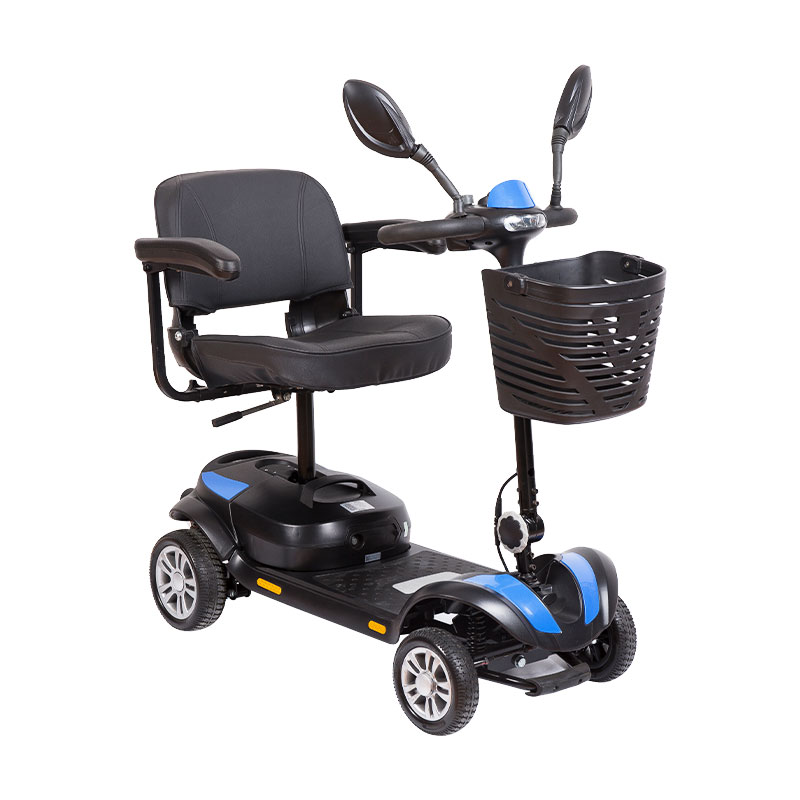Stability and anti-rollover of steering mechanism of old scooter when turning
The steering mechanism of an Elderly Mobility Scooter is carefully designed to ensure stability and prevent rollover when turning, particularly considering the needs and limitations of elderly users. Achieving this balance requires engineering techniques that enhance both maneuverability and safety. Here's how the steering mechanism works to ensure stability and anti-rollover during turns:
1. Center of Gravity Consideration:
- Engineers analyze the scooter's weight distribution and center of gravity to ensure that it remains low and centered even during turns.
- Lowering the center of gravity enhances stability and reduces the likelihood of tipping.
2. Anti-Tip Wheels or Casters:
- Many mobility scooters are equipped with additional small wheels or casters at the rear or front to act as stabilizers during turns.
- These anti-tip wheels provide extra points of contact with the ground, preventing the scooter from tilting to the side.
3. Tilt and Lean Control:
- Some advanced scooters use tilt and lean control systems that allow the scooter to lean into turns, similar to the way a cyclist leans.
- This technology distributes the lateral forces more evenly, reducing the risk of tipping.

4. Steering Dampers:
- Steering dampers or shock absorbers are integrated into the steering system to dampen sudden movements and stabilize the scooter during sharp turns.
- These dampers reduce the impact of lateral forces on stability.
5. Dynamic Stability Control (DSC):
- Some scooters incorporate DSC systems that automatically adjust wheel speeds based on the scooter's orientation and the user's steering input.
- DSC prevents the scooter from overturning by adjusting wheel speed differentials during turns.
6. Electronic Stability Program (ESP):
- Similar to systems in cars, ESP uses sensors to monitor the scooter's behavior and intervenes by adjusting brake and motor power to prevent skidding or tipping.
7. Gradual Speed Adjustment:
- The steering mechanism is designed to allow gradual speed adjustment during turns to avoid abrupt shifts in weight distribution.
- Gradual adjustments reduce the risk of instability caused by sudden movements.
8. Anti-Rollback Function:
- Some scooters incorporate an anti-rollback function that prevents the scooter from rolling backward when stopped on an incline.
- This feature ensures that the scooter remains stable when transitioning from a stop to a turn on an incline.
9. User Training and Education:
- Manufacturers provide guidelines and user training to inform elderly users about safe turning practices, such as slowing down before turning and maintaining a balanced posture.
10. Real-Time Monitoring:
- Advanced scooters may have sensors that continuously monitor the scooter's orientation, speed, and movement.
- Real-time monitoring allows the control system to make instantaneous adjustments to maintain stability.
11. Testing and Simulation:
- Engineers conduct rigorous testing and simulation of the scooter's behavior under various turning conditions to validate stability and anti-rollover measures.
The steering mechanism's engineering is focused on harmonizing maneuverability and stability. By implementing these techniques, Elderly Mobility Scooters ensure that users can confidently navigate turns without compromising safety and stability, even in challenging environments.


 English
English Deutsch
Deutsch







-3.jpg?imageView2/2/format/jp2)
.jpg?imageView2/2/format/jp2)






